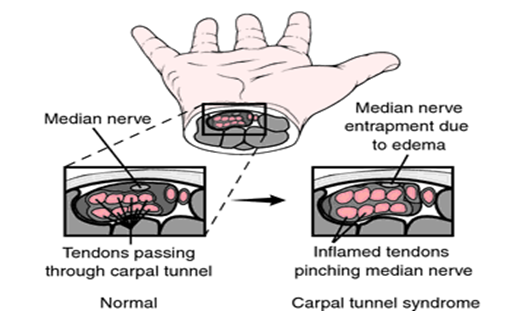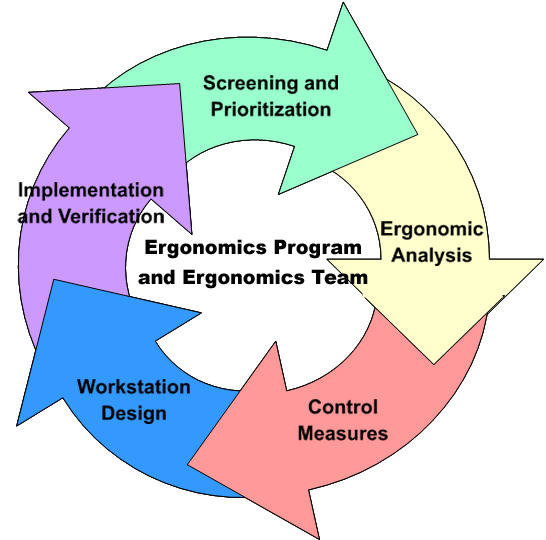Abstract
Carpal Tunnel Syndrome and Epicondylitis are some of the most pronounced workplace injuries that limit the efficiency of workers. This paper offers a consummate discourse regarding the concept of Carpal Tunnel Syndrome and Epicondylitis at the workplace.
It addresses the prevalence of the conditions at the workplace and their management as a way of enhancing efficiency at the workplace. The paper finds that the disastrous effects of the two injuries can be greatly reduced through application of ergonomic principles.
Introduction
Achieving Workplace Efficiency through the Practice of Ergonomics
Effectiveness of the human resource in an organization is a factor of the organizational success. Healthy personnel in an organization contribute immensely to the success of an organization. Moreover, health of the employees is a subset of the work conditions of the workers.
Health defines the quality and the quantity of the work input by the workers. In this regard, an organization’s primary obligation is to institute measures of ensuring workers are at their optimal health. Therefore, principles of ergonomics in the workplace should be invariably observed (Konz, 2011).
Literature Review
Carpal Tunnel Syndrome
Carpal Tunnel Syndrome hinders the efficiency at the workplace. The condition affects the palm area of the hand leading to numbness. The defect impairs the coordination of the muscle movement in the palm of the hand thereby causing intense pain.
Because of the vitiated coordination in the palm region, grasping of objects becomes a grueling affair. Poor muscle coordination also leads to impaired movement of the hands. The fact that the hand achieves 99% of the workplace chores makes the condition a severe affair that must be controlled (Karwowski & Salvendy, 2011).
Epicondylitis
Rigorous tasks can render elbows redundant. In addition, overuse of an elbow leads to the development of pain in the human elbow. The tendons and muscles that join the forearm from the exterior parts of the hand may get inflamed because of uncontrolled movement, and lots of force exerted on the muscles.
When the arm experiences “repetitive motions,” the damage may lead to “Epicondylitis,” or “Tennis Elbow”. For tasks that involve constant movements at the workplace, the workers are likely to develop Epicondylitis, unless good principles of work safety are adopted (Konz, 2011).
Figure 1: Illustration of CTS

Source: (Konz, 2011)
Figure 2: Illustration of Epicondylitis

Source: (Konz, 2011)
Ergonomic principles involved with movements
Working at proper and comfortable heights
Many people may not know that height is a fundamental factor in the determination of safety at the workplace. The inclination of the hand and the palms are very significant factors in ascertaining the safety of the hand. The strain on the functioning of the hand interferes with the muscles and the nerve responses in the hand.
The movement can be initiated by poor gravitational inclination of the hand, which necessitates the individual to be wary of the inclination of the arm. Epicondylitis does not occur due to “positional misjudgment” of the arms, but rather movement.
Therefore, the ergonomic principles involved in the management of Tennis Elbow, are fundamentally different from those principles involved in the management of CTS. Poor positioning of the arm and intense force on the palm of the hands due to overstretching induces the condition.
Remedying the condition requires the adoption of ergonomic principles that ensure that the hands are kept at a position where stretching is limited. Management of Epicondylitis involves limiting excessive motions of the arm especially when carrying heavy loads. Epicondylitis advances in cases where the work process involves repetitive motion of the arms carrying a heavy load.
Repetitive movement and stress
Repetitive movement of the arm and the hands is a predisposing factor to the two conditions. The need to shun monotonous movements involving the joints while carrying heavy loads should be emphasized. Workers must be trained on how to limit these movements to evade “wear” and “tear” of their joints.
Consequently, it is important to avoid strenuous elbow movements to avoid stretching the muscles of the hand beyond their “elastic limit.” The muscles of the arm should be accorded minimal load especially when these muscles are under movement. Cases of Carpal Turner Syndrome require that strain and stress leading to muscles shearing be eliminated.
Design of hand tools should consider the template of ergonomic principle in the workplace. Intelligible designation of the tool handles is fundamental to limiting injuries at the workplace. Specifically, the case of Carpal Tunnel Syndrome will be significantly reduced.
From these assertions, it is clear that there is a distinction between the ergonomic principles in the management of CTS and Epicondylitis (Kroemer, Kroemer & Elbert, 2001).
Why CTS and Epicondylitis continue to be unobserved
Poor observation of good work ethics
Poor work ethics is a factor that has largely contributed to increased injuries. CTS and Epicondylitis problems are widespread at the workstations as the staffs have ineffective enforcement programs to curb these episodes of injury at the workplace.
The paper will briefly shift focus to explore the reason injuries have been associated with CTS and “Tennis elbow” syndrome continue to be witnessed amongst the workers (Kroemer, Kroemer & Elbert, 2001).
Rigidity to adopt, and stick to the established ergonomic principles
Enforcement of these ergonomic principles has faced ferocious resistance from most workers. Issues like positioning of the arms, the limbs, the back, and even the hands are very critical in the management of the workplace injuries. However, they have invariably been ignored.
Workers are severely used to workplace indolence that makes it quite hard for them to adopt these new and effective models of maintaining a healthy life at the work place.
Carpal Turner Syndrome continues to be a primary concern for employers despite the training of the staff to restructure their work techniques. As long as a change of attitude is not witnessed at the workplace, management of CTS and Epicondylitis remain a mirage (Kroemer, Kroemer & Elbert, 2001).
Nature and design of the tools usable in the workplace
Occupational health experts have shifted blame on the injuries at the workplace to indigent design of the tools used. Experts attribute 50% of the workplace injuries to the tools that workers use. The designs of these tools are prerequisites for these injuries. Handles of the commonly used tools, for instance, have been “accused” of enhancing injuries especially cases of CTS (Konz, 2011).
Rigidity by most employers
To adopt new technologies to avoid injuries. Good workplace ergonomic strategies include adoption of new industrial technologies that considerably reduce injuries at the workplace.
Adoption of new technologies that are comfortable to use and achieve optimal results is essential in handling cases of workplace injuries. Nevertheless, most employers are unwilling to replace the inefficient machines with these highly efficient technologies where injuries are not easily experienced (Konz, 2011).
Discussion
Structuring of an effective ergonomics plan
In an industrial manufacturing setting, rotational duty strategy is crucial. One of the contributing factors to workplace injuries is the fact that some workers are repetitively involved in the same chore. There is a need to rotate the workers to avoid the impact of stress on the same muscle. The following framework is critical in the reduction of “exposure hours” to the agents of injury (Kroemer, Kroemer & Elbert, 2001).
Figure 3: Illustration of program design for workplace safety in a manufacturing plant

Source: (Konz, 2011)
Design of tools
Flexible design of workplace tools is fundamental for an efficient ergonomics program. To reduce CTS and Epicondylitis, proper handling of tools in the workplace must be encouraged. Purchase evaluation of these tools should be done. Extreme strain on one arm is the root cause of CTS and Epicondylitis. Balanced use of both hands should be encouraged.
In addition, a policy framework that requires workers to make use of both their hands should be designed to distribute the strain of work on both arms. Purchase of tools and equipment should be anchored on assessment report by ergonomists. Efficient evaluation of tools must be part of the procurement process while purchasing tools for the company (Trzcieliński, 2013).
Workplace screening
Konz (2011) proposes an elaborate model of intermittent health screening of workers to assess the effects of work on their health. The screening is crucial in establishing if the workers are exposed to injuries. Early interventional measures are significant in managing workplace injuries. Screening of workers assists the management in diagnosing workplace injuries on time.
Any establishment of ergonomic programs must be based on research and evaluation. The screening process gives managers an insight into the causes of workplace injuries. A systematic screening program should be instituted to effect early intervention measures for workplace injuries (Alexander & Rabourn, 2011).
Conclusion and Future Study
Workplace injuries are quite common. Epicondylitis and Carpal Tunnel Syndrome are some of the most common forms of injuries. The study focused on the possible application of ergonomics to establish safer workplaces with regard to these injuries.
The study finds that with the help of workers, managements can set up structures that greatly reduce the injuries. For instance screening, and setting up structures approved by experts. Future studies may focus on finding out the extent to which applications of ergonomics contributes towards workplace satisfaction or performance.
References
Alexander, D., & Rabourn, R. (2011). Applied ergonomics. London: Taylor & Francis.
Karwowski, W., & Salvendy, G. (2011). Advances in human factors, ergonomics, and safety in manufacturing and service industries. Boca Raton, FL: CRC Press.
Konz, S. (2011). International ergonomics association ergonomics international news and information. Ergonomics, 34 (6): 849-866.
Kroemer, K., Kroemer, H., & Elbert, K. (2001). Ergonomics: How to design for ease and efficiency. Upper Saddle River, NJ: Prentice Hall.
Trzcieliński, S. (2013). Advances in ergonomics in manufacturing. Boca Raton, FL: CRC Press.